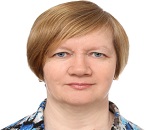Nadezhda V Vernikovskaya
Boreskov Institute of Catalysis SB RAS, Russia
Title: A modelling approach to deal with the particulate matter pollutants: filtration of diesel soot and suspensions

Biography:
Nadezhda V Vernikovskaya is senior researcher at Boreskov Institute of Catalysis SB RAS (BIC SB RAS), Novosibirsk, Russia, Associate Professor, Faculty of Natural Sciences, Novosibirsk State University (NSU) and Associate Professor, Aircraft Faculty, Novosibirsk State Technical University (NSTU). She has completed her PhD in 1996. She has written approximately 100 peer reviewed journal articles, book chapters and conference papers. Most of her research has focused on modeling and simulation of such heterogeneous catalytic reactors as tubular reactor, fluidized bed reactor, structured catalytic reactor and so on; soot particulates abatement in diesel engine exhaust by their trapping in filters; filtration of the catalysts suspension in hydrogenated oil through the woven cloth.
Abstract:
In the modern world, there is always a huge amount of solid waste caused by human life and harmful to nature and people. Solid waste may be small particles in a liquid or gas mixture. Filtration processes can be used to capture these particles from mixture in order to reuse them or simply to reduce their content in the mixture being cleaned. Mathematical modeling of filtering processes can help reduce experimental efforts during filtration processes development. The purpose of the study was to develop an Equation-Oriented approach to modeling filtration processes, the aim of which is to reuse trapped particles and / or reduce the content of particles in the mixture being cleaned.
The approach is to create a model of the necessary and sufficient degree of complexity, to develop an effective algorithm for solving model equations and create a program code. The model takes into account the main necessary features of the system: unsteady-state behavior, geterogeneity of the system, convective mass transfer of particles in mixture along the filter depth, penetration of particles through the filter, accumulation of particles inside the filter pores, deposition of coarse particles and particles due to inertial collision on the outer filter surface, particles size distribution. A sufficient degree of complexity is the use of one-dimensional models, since the transfer of particles occurs only in one direction.
The algorithm is based on the three existing methods and takes advantages of each of them: the method of lines, the running scheme, and the second order Rosenbrock method with stepsize adjustment algorithm. The approach has been applied to the modeling of such filtration processes as soot particulates abatement in diesel engine exhaust and filtration of the catalysts suspension in hydrogenated oil through the woven cloth. Verification of the mathematical model and numerical method is done by means of comparison of the numerical results with the experimental data. Using this approach to modeling various filtering processes it is possible to predict the performance of filters and to select the filtering material with the proper specifications for efficient reducing particle content in the mixture being cleaned. The captured solids can be then reused if necessary. This work was conducted within the framework of budget project No. 0303-2016-0017 for Boreskov Institute of Catalysis.